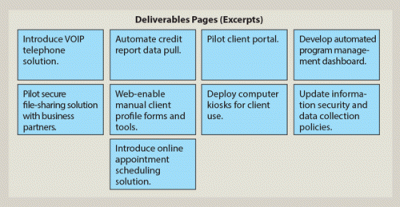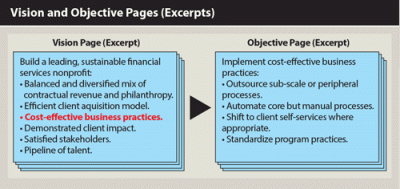Journal of Financial Planning; June 2014
Findings from the FPA Research and Practice Institute™ 2013 Future of Practice Management Study show that 50 percent of financial advisers don’t have a written business plan. Are you one of them? If so, consider using our firm’s business planning process as a starting point for creating your own plan.
In 2012, our seven-person firm faced two seemingly independent growth challenges: how to formalize our growth opportunities into a single, strategic planning document; and how to institute a performance management process for our growing staff.
Rather than tackling these issues separately, we integrated them into a single business-planning process. The result: an annual business plan that clearly links our long-term growth strategy to each staff member’s short-term responsibilities for the coming quarter and year.
This new planning process, which we deployed in 2013 and 2014, has proven to be an important management tool for our firm. It has helped us get more work done, but more critically, it has helped us get the right work done. We know the work we are completing now is laying the groundwork to achieve our growth objectives and vision over the coming years.

4 Steps to an Annual Business Plan
Our annual business plan contains four integrated steps. Each step has a distinct purpose but ties directly to the next step. In total, the plan is just 10 pages long.
Step 1: Vision. This step succinctly articulates the firm we want to become over the next three to five years. It includes just four items that capture our external and internal vision. The external vision describes our ideal client and the set of services that are most compelling to that client and most distinctive in our marketplace. The internal vision describes the type of sustainable business we want to build and the growth benchmarks we want to achieve.
Step 2: Objectives. This step begins to describe how we will achieve our vision. It includes eight major objectives that we must accomplish over the next three years. Each objective is too large to complete in a single year. The descriptions are high-level, containing only enough detail to offer a clear image of the scope and focus of the objective.
Step 3: Deliverables. This step takes each of our objectives and describes what we need to complete in the current year to ultimately accomplish the objectives over the next three years. For 2014, we established 54 deliverables (six or seven per objective). The descriptions are detailed, because they need to be assigned to staff members and tracked over the course of the year.
Step 4: Roles and responsibilities. This final step takes each deliverable and assigns it to one or more staff members. Every deliverable has at least one clearly assigned leader, and the more complex ones have additional leaders and helpers. The descriptions include a set of tasks, as well as the metrics that will be used to measure completion and performance.
Performance Management Process
Our performance management process builds directly from the roles and responsibilities outlined in the business plan. At the beginning of each year, staff members use the roles and responsibilities pages to plan out their year and create individual performance plans. They break down their assigned deliverables into quarterly tasks and coordinate activities with others if a deliverable has multiple leaders/helpers.
These individual plans form the basis of quarterly performance reviews. At the end of each quarter, staff members complete a self-assessment of their performance against their assigned responsibilities. They use a standardized template that we created to facilitate this process. After the self assessments are complete, one-on-one meetings are held with each person’s manager to review accomplishments, discuss strengths and development areas, and prepare for the coming quarter.
At the same time, our executive director leads a group discussion of firm-wide progress against our deliverables. During the meeting she highlights our major accomplishments as well as the initiatives that are still outstanding, and sets the stage for the remainder of the year by underscoring the activities that will be most critical to our success.
Separately, she holds a comparable discussion with our firm’s board of directors to update them on our priorities and progress. In that context, the business plan is proving to be an effective communication and governance tool.


The Business Plan in Action
As an example of our four-step business plan, I will highlight the projects we have underway to become a more cost-effective organization.
Like all of our work, these projects can be tied back to a much broader vision and set of objectives. The vision guiding these projects is to build a leading, sustainable financial services nonprofit. This vision encompasses a wide range of areas, including revenue generation, client impact, stakeholder satisfaction, and talent acquisition. Because of its breadth, this vision alone triggers multiple objectives. One of them is to implement cost-effective business practices, which describe four specific ways we want to become more cost-effective. These descriptions are intended to express a clear vision of where we want to focus our work over the next three years, not to define particular projects.
Next, the deliverables included in the plan describe the initiatives we must complete this year in order to ultimately achieve our objectives and vision. For 2014, nine deliverables are associated with the objective to implement cost-effective business practices.
Ultimately, all of these deliverables need to be resourced and completed. Each of the nine initiatives is assigned to one or more leaders and helpers on the roles and responsibilities pages of our plan. These staff members then build the work into their individual performance plans, and progress is monitored quarterly.
Inspiration for the Plan
The inspiration for our planning process came from three sources. Two are unique to my own work experience. Earlier in my career, I worked at the Boston Consulting Group and learned how to create clear, actionable strategic plans. Later I worked at Bank of America’s private bank, were I used a highly effective quarterly performance planning process. My final source of inspiration is the publicly available series of One Page Business Plan books by Jim Horan. I recommend them to any business leader wishing to explore a simple yet powerful methodology.
Developing the Plan
The first version of the business plan took roughly 40 hours over six weeks to complete. It was mostly a two-person effort. I led the process and created rough drafts, and our executive director reviewed and edited each draft. When we were happy with the plan, we shared it with all staff and incorporated their feedback into a final version.
In our drafting sessions we completed each of the four steps in order, starting with the vision section. Much of our time was spent carefully articulating the vision and objectives for our firm. We went through several iterations until we were satisfied with the content and tone. The rest fell together more quickly, and the rollout to our staff was surprisingly easy, because the sections of the plan tie together logically and cohesively.
Since then we have completed our first annual refresh. The process was easy, requiring about eight hours over two weeks to complete. It was again a two-person effort, with the entire staff providing feedback toward the end. We barely needed to edit the vision and objectives sections, and mainly focused on updating the deliverables and roles and responsibilities for the coming year. We feel the stability of the plan year-over-year is a positive indicator that our growth strategy and supporting initiatives are sound.
Benefits of the Plan
Our annual business plan has delivered benefits in four important areas:
Strategic growth:
- Helped us define our ideal customer and set of services. We are now able to screen prospects more quickly and with less effort.
- Increased our focus on longer-term goals, because day-to-day responsibilities are now directly linked to long-term growth objectives.
Communication:
- Helped us succinctly articulate our vision and mission. We have incorporated statements from the plan into our external presentations and marketing materials, making our messaging more consistent and powerful.
- Increased our level of communication about priorities and progress among staff and our board.
Job performance and satisfaction:
- Increased our focus on job performance. Each staff member now has well-defined quarterly responsibilities and is evaluated based on achievement of those duties.
- Enhanced employee satisfaction. Staff members report that they like having well-defined responsibilities and knowing how those duties help the firm grow over the longer-term.
Capacity management:
- Helped us identify bottlenecks. As roles and responsibilities are defined, it quickly becomes clear where staff members or functions are overburdened. This has enabled us to strategically add resources where they are needed most.
- Increased our flexibility and responsiveness to new opportunities that arise during the year. New options are evaluated against our existing list of responsibilities. If a new project has greater strategic value than an existing project and fits within our capacity constraints, then we replace the existing project with the new one, with full knowledge of the trade-offs we are making.
Worth the Investment
The investment of time and resources we made in this process has been worthwhile. Our business plan has become an important management tool for our firm, and we are realizing both short-term and longer-term value from the process. We are excited to see what we can achieve this year and how those accomplishments will help us fulfill our vision over the coming years.
Stephen Barkhuff, CFP®, CFA, is the deputy director of financial services at Compass Working Capital. His work is focused on helping underserved individuals and families achieve their financial goals. He is the 2014 recipient of the Diversity Scholarship for FPA Retreat.